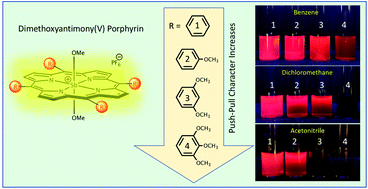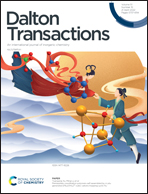Antimony(+5) ion induced tunable intramolecular charge transfer in hypervalent antimony(v) porphyrins†
Abstract
The +5 oxidation state of antimony induced push–pull style intramolecular charge transfer in an elegantly designed axial dimethoxyantimony(V) porphyrin series: SbP(OMe)2·PF6, SbMP(OMe)2·PF6, SbDMP(OMe)2·PF6, SbTMP(OMe)2·PF6 with phenyl (P), 4-methoxyphenyl (MP), 3,5-dimethoxyphenyl (DMP), and 3,4,5-trimethoxyphenyl (TMP) units, respectively, in its meso positions. The Sb(+5) made the porphyrin ring electron-poor, whereas the methoxy groups on the phenyl unit produced electron-rich sites within the molecule. The presence of electron-poor and electron-rich parts in the same molecule resulted in a push–pull type intramolecular charge transfer (ICT). However, the ICT is strongly dependent on the position of the methoxy groups on the phenyl ring. The charge transfer character is more pronounced in meta-methoxy substituted antimony(V) derivatives (SbDMP(OMe)2·PF6, SbTMP(OMe)2·PF6) than the para-methoxy or no-methoxy substituted antimony(V) derivatives (SbP(OMe)2·PF6, SbMP(OMe)2·PF6). Steady-state and transient spectroscopic techniques, as well as solvatochromism techniques, were employed to establish the tunable ICT. Additionally, time-dependant density functional theory (TD-DFT) calculations were used to complement the experimental results. The systematic study of antimony(V) porphyrins, especially the tunable push–pull nature could play an important role in instigating high yield charge-separated states in multi-modular donor–acceptor systems for solar energy conversion and molecular electronic and photonic applications.



 Please wait while we load your content...
Please wait while we load your content...